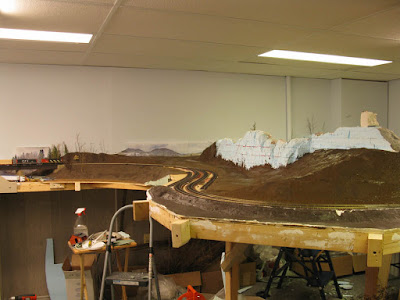I’ve never
being a well-organized man. While I can plan a lot, most of the time, I act on
the spur of the moment. Last Saturday night, when Louis-Marie asked us what he
could do on the layout, I jokingly suggested him to design a dirt cheap way to
make working grade crossing signals. I was half serious, knowing he could
easily put it off, but I didn’t expect it to be done so quickly and with a high
level of craftsmanship.
Grade
crossing signals and detection systems are notoriously costly. Add raising
shipping cost and exchange rate and it can quickly become ludicrous. Worst, out
of 6 signals on our layout, 4 are a special kind you can’t find in HO scale. To
make 2 working grade crossings it would cost us at least 500$, maybe more…
Here enters
Louis-Marie’s creative mind. He used an
old CD-ROM driver to play a custom made CD with looping grade crossing signal
sound. Jérôme handled the sampling and
looped seamlessly the sound file so it could run for 74 minutes. This way, we
have a correct sound file for a Canadian crossing. The CD-ROM driver was then
wired to a speaker. We still have to find a suitable speaker for this purpose.
Our mockup wasn’t loud enough and locomotive sound made it impossible to hear.
The next
step was to make a 555 module to control the signals’ flashing red LEDs which
only took a few minutes with parts from the junk box.
 |
| The real signal at Sous-Bois street crossing in Villeneuve (credit: Unknown) |
Meanwhile,
I scaled down a picture of the real life signal located at Ciment St-Laurent
and started to cut and drill brass tubes from scrapped HO components.
Engineering had to be extremely precise to get enough clearance for small wires.
It was also required to make sure every brass tube would fit others. I didn’t
want to rely solely on solder and decided to make tubes connect in each other.
I wired the signal before soldering the parts because it would have been
impossible otherwise.
Louis-Marie
soldered the brass tubes together and assembled LEDs back to back. The level of
precision is quite impressive. He also used shrink tube around the LED to hide
their back and make a housing against which the black target will seat. Speaking of target, we found out Kadee red truck
spacers are perfect for 3 mm LED!
Finally, we
scratchbuilt a custom ladder made of stiff electrical copper wire. It looks
complicated, but in fact, making your own ladders out of wire is a piece of
cake. With a Dremel cutoff wheel, I sanded down solder blobs and cut to length the
soldered rungs. You are better starting off with longer parts, solder them then
adjust the final dimension. It’s easier and it yields better results.
At this
point, I added a plastic signal base scavenged from an old HO scale grade
crossing signal. Seriously, I always thought HO scale signals were oversized,
but they are at least S scale!
Finally, we
tested the entire system with lights and sound… and it works flawlessly. Total
cost: Nothing and it’s closer to prototype than we could have wanted. I shoot a few very crappy movies to show the result.
Now, you
may want to ask me how we will operate the signals. Detectors are a no go. We
once tried to design a circuit for each crossing and it wasn’t easy. The
problem is each grade crossing has multiple tracks and an uneven number on each
side to boot. It would require many detectors and it could be hard to wire
everything to work flawlessly. Also, switching operations requires that the
signals can be turn off depending circumstances.
Thus, we
decided to settle on something more low-budget and simpler to operate. Each
grade crossing system will be operated with a regular on-off switch controlling
the CD-ROM drive and flashing module. To make sure there’s any delay with the
sound file when the flashing system start, the CD will play continuously. In
fact, the switch will act as a muting device… idem for the lights.
We are
actually discussing the possibility to control the signals with two 3-way
switches. Each would be located a few feet away from the crossing were a
detection unit should be located. The train operator will turn them on when the
locomotive will reach this spot and turn them off when the train clear the
crossing. In later days, Murray Bay Subdivision telegraph poles only carried
detection signal wires. Thus, on the layout, the switch will be located under
the last telegraph pole.
The system
is not perfect, but there’s a lot of improvement possible later. Making scale
signals is relatively easy and rewarding. The cost is also very low and it was
only required to buy some brass tube to make more signals. The first signal,
which is also the most intricate, took about 2 hours to build at a leisure
pace. Making several signals in an assembly line fashion should be a piece of
cake.
By the way, the idea of using CD-ROM drive to handle sound files
on the layout will be kept for other ambient sound. This includes industrial
sounds near the major factory (Donohue and Ciment St-Laurent) and background
sounds like river flowing, ducks and wildlife in the more rural parts of the
layout in the same fashion Trevor Marshall do with his Port Rowan S Scale
layout.

































